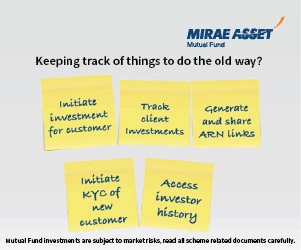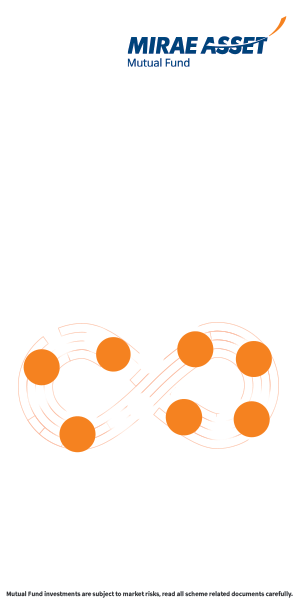Mutual Fund Review: Reliance Banking Fund is the best in class

Reliance Banking Fund is the best BFSI sector fund in the last five years, on the basis of trailing annualized returns. The Banking, Financial Services and Insurance sector (BFSI) sector has the highest weightage in both Sensex and Nifty. The performance of this sector is closely correlated with the overall economic growth in the country. BFSI as a sector has underperformed with respect to the broader market over the last one year period. The chart below shows the last one year daily price movements of the S&P BSE Bankex (the Index for BFSI stocks), and the Sensex, indexing prices of both the indices on Mar 23 2013 to zero.

The green line graph clearly shows that BFSI as sector has lagged behind the market (in blue line). The returns, in fact, had been negative for most part of last one year. A recent rally in some banking stocks, have taken the last one year returns to the positive territory to 7.3%, while during the Sensex has risen over 16%. The reason for the weak performance of this sector is well known. With economic slowdown the demand for credit has remained subdued. High inflation and interest rates have hurt the sector. The asset quality has worsened in this period, with increase in NPAs and write offs. The short term outlook is mixed
- With general elections around the corner, business sentiments and reforms program will pick up if we get a stable government
- It will take a longer time for investment cycle to revive. Therefore, demand for corporate credit may remain sluggish in the short term
- Though there are signs of inflation cooling off, the inflation level is still high and the lowering of interest rates will be gradual
- Asset quality will continue to be a concern
However, from a long term viewpoint this sector presents attractive opportunities. Many experts believe that equity markets are bottoming out, even though the market may further go down by a few percentage points in the short term. It goes without saying that, the BFSI sector will lead the return to long term bull market. From a fundamental perspective, some private and public sector banks are trading at attractive valuations. There are also structural changes taking place in this sector. A set of new banks will get banking licenses from the RBI later this year. New norms of NPA recognition once implemented, will lead to improvement in asset quality in the future. As a result of these changes the health of the BFSI sector will surely improve.
From a risk perspective, diversified equity funds offer more risk diversification compared to sector funds, where investors are exposed to sector risks. Changes in central government and RBI policies, as well industry specific issues of the debtors, may impact the BFSI sector, either in a positive or a negative way. This sector is also a high beta sector, which means that the volatility in this sector is very high. As such investors with a short term horizon should stay away from this sector. However, for well informed active investors, BFSI funds can be good investment opportunities in the medium term, due the reasons mentioned above. The chart below shows the comparison of annualized BFSI average category returns over one, three, five, seven and ten years time horizons, with large cap fund category (NAVs as on Mar 22). While the BFSI has clearly underperformed in comparison to large cap funds in the short term, it has outperformed in the long term, five to ten years time horizon
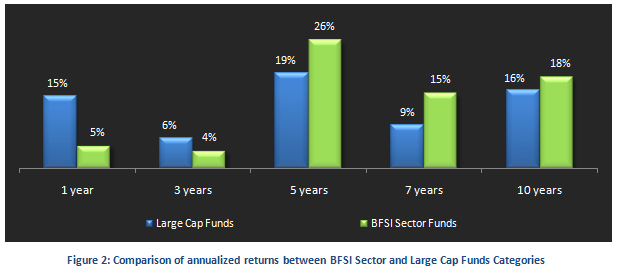
Reliance Banking Fund, which completed 10 years in 2013, is clearly a top performer in this category based on last 5 year annualized returns. See the chart below, for the comparison of annualized returns over one, three, five and ten year periods, between Reliance Banking Fund (Growth) and the BFSI Sector Funds Category (NAVs as on Mar 22)
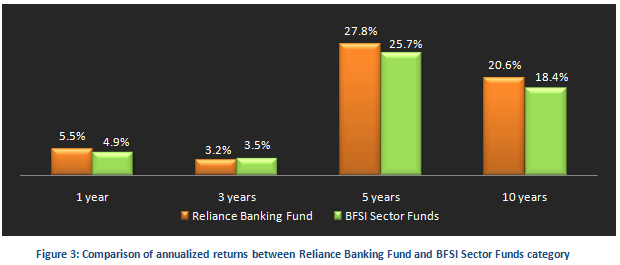
Reliance Banking Fund – Fund Overview
The Reliance Banking Fund was launched in May 2003. The scheme is open both for growth and dividend plans. The fund has an AUM base of over Rs 1,300 crores, with an expense ratio of only 1.92%. Reliance AMC is one of the oldest and largest asset management companies in the country. The fund managers of this scheme are Sanjay Parekh (since 2012) and Shrey Loonker (since 2010). The current NAV (as on Mar 22 2014) is 110.7 for the growth plan and 33.1 for the dividend plan.
Portfolio Construction
The fund manager has a large cap and high growth potential focus for his portfolio. The fund had a high exposure to State Bank of India and low exposure to HDFC Bank in 2011 – 2012. Since SBI had been underperforming relative to HDFC Bank, the fund lagged behind its peers (as is evident in the chart above). The fund managers have now rebalanced the portfolio with substantial exposure (nearly 21%) to HDFC Bank, and the performance has improved with the Reliance Banking Fund outperforming the category in terms of one year trailing returns. In terms of company concentration, the top 5 holdings, HDFC Bank, ICICI Bank, J&K Bank, Bajaj Finance and HDFC Limited account for over 56% of the total portfolio value.
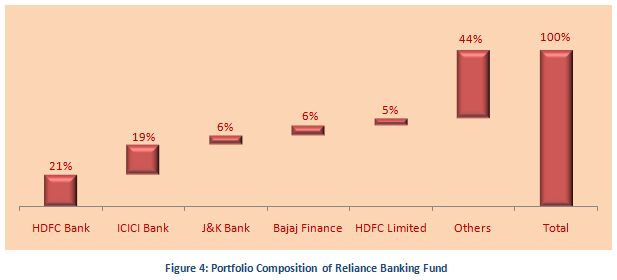
Risk & Return
From a risk perspective, the volatility of the fund is in line with the BFSI Sector Funds category. The annualized standard deviations of monthly returns of Reliance Banking Fund for three to ten year periods are in the range of 30% - 32% respectively. On an absolute basis the standard deviations of returns are high, but one has to remember that BFSI sector is a high beta sector and therefore higher volatilities are only to be expected. One needs to look at returns in conjunction with risk, when evaluating BFSI sector funds. On a risk adjusted return basis, as measured by Sharpe Ratio, the fund has outperformed the BFSI Sector Funds category. Sharpe ratio is defined as the ratio of excess return (i.e. difference of return of the fund and risk free return from Government securities) and annualized standard deviation of returns. Higher the Sharpe ratio better is the risk adjusted performance of the fund. See charts below for comparison of volatilities and Sharpe ratios between Reliance Banking Fund and the BFSI Sector Funds Category.

Comparison with Peer Set
A comparison of annualized returns of Reliance Banking Fund versus its peer set over various time periods shows that despite relative short term underperformance, this fund is top performer in the 5 year time frame. See chart below for comparison of trailing annualized returns over one, three and five year periods. NAVs as on Mar 22, 2014.
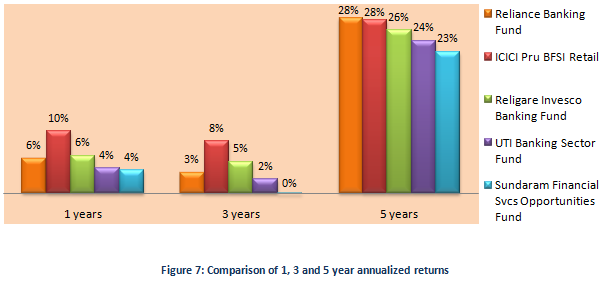
Dividend Payout Track Record
Reliance Banking Fund Dividend Option has a good dividend payout track record. In its 10 year history, the fund has paid dividends every year, except 2004, 2008 and 2010.
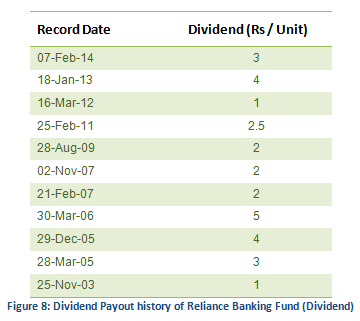
SIP and Lump Sum Returns since Inception
The chart below shows returns as on Mar 22 2014 (NAV of 110.7) of Rs 5000 monthly SIP in the Reliance Banking Fund Growth Plan, for respective years since inception (in May 2003). The SIP date has been assumed to first working day of the month. The amounts are shown in Rs lakhs.
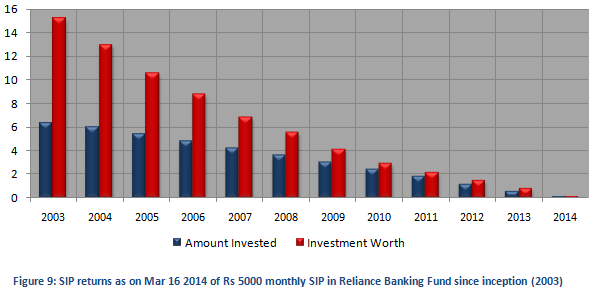
The chart above shows that, a monthly SIP of Rs 5000 from the first working day of the month since inception would have grown to nearly Rs 15.2 lakhs, while the investor would have invested in total only about Rs 6.3 lakhs. This would imply an internal rate of return of more than 13%. This is despite, the relative underperformance of this sector over the last couple of years. As and when the economy recovers, the IRR is bound to increase even further.
If the investor had invested Rs 1 lakh in the NFO, his or her investment would have now grown to over Rs 11 lakhs.
Conclusion
The Reliance Banking Fund has delivered over 10 years of strong performance. Though the fund’s performance record in the recent past has been mixed, it remains a good bet as a medium to long term investment. Investors with high risk appetite and medium to long time horizon can consider buying the scheme through the systematic investment plan (SIP) or lump sum route. The fund has a good dividend payout track record, and as such may appeal to investors who prefer dividends. Since the fund manager is relatively new, investors should monitor the performance of the fund to see if the fund manager can deliver good returns, in the next few years. Investors should also ensure that the objectives of the fund are aligned with their individual risk profiles and time horizons. Investors should note that thematic funds such as this, however, are suitable only for those investors who can monitor market trends and book profits at the right time.
Queries
-
What is the benefit of mutual fund STP
Aug 29, 2019
-
How much to invest to meet target amount of Rs 2 Crores
Aug 26, 2019
-
Can I achieve my financial goals with my current mutual fund investments
Aug 24, 2019
-
Can you tell me return of various indices
Aug 19, 2019
-
What would be the post tax return on different investments
Aug 18, 2019
-
Which Principal Mutual Fund scheme will be suitable for my retirement corpus
Aug 16, 2019
-
What is the minimum holding period for availing NCD interest
Aug 4, 2019
Top Performing Mutual Funds
Recommended Reading
Fund News
-
The Wealth Company Mutual Fund launches The Wealth Company Gold ETF FOF
Jan 9, 2026 by Advisorkhoj Team
-
Mahindra Manulife Mutual Fund launches Mahindra Manulife Innovation Opportunities Fund
Jan 9, 2026 by Advisorkhoj Team
-
Jio BlackRock Mutual Fund launches Jio BlackRock Short Duration Fund
Jan 8, 2026 by Advisorkhoj Team
-
Jio BlackRock Mutual Fund launches Jio BlackRock Low Duration Fund
Jan 8, 2026 by Advisorkhoj Team
-
Groww Mutual Fund launches Groww Small Cap Fund
Jan 8, 2026 by Advisorkhoj Team





